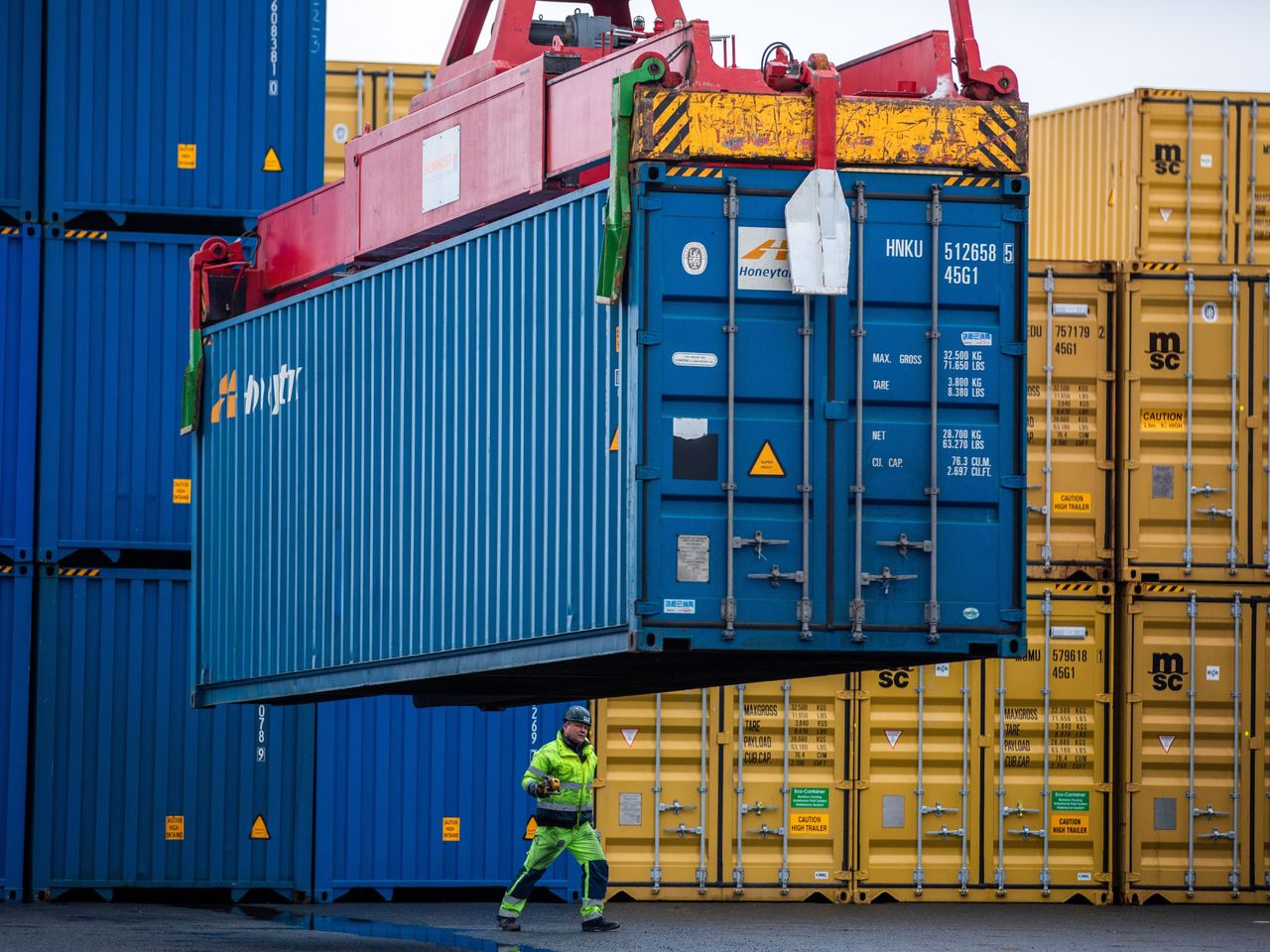

Finance
Why Are Shipping Stocks Down
Published: January 19, 2024
Discover the reasons why shipping stocks are experiencing a downturn in the finance industry. Gain insights into the market dynamics and potential implications for investors.
(Many of the links in this article redirect to a specific reviewed product. Your purchase of these products through affiliate links helps to generate commission for LiveWell, at no extra cost. Learn more)
Table of Contents
Introduction
Welcome to the world of shipping stocks, where the waters can be tumultuous and unpredictable. For investors and traders, the performance of shipping stocks can often be a reflection of the overall health and stability of global trade. In recent times, however, shipping stocks have experienced a downturn, leaving many investors wondering why.
There are several key factors that have contributed to the decline in shipping stocks. This article will explore these factors and shed light on the current challenges facing the shipping industry. From the impact of a global trade slowdown to the effects of the COVID-19 pandemic, we will delve into the various forces at play.
Understanding the reasons behind the decline in shipping stocks is crucial for investors and financial analysts alike. By examining the underlying causes, we can gain valuable insights into the current state of the shipping industry and make informed decisions about investments and trades.
So, let’s embark on this journey to uncover why shipping stocks are down and navigate the complex waters of the global shipping industry.
Impact of Global Trade Slowdown
One of the primary factors contributing to the decline in shipping stocks is the global trade slowdown. International trade plays a critical role in the shipping industry, as it involves the transportation of goods across borders. When global trade experiences a downturn, it directly affects the demand for shipping services.
In recent years, various economic factors have contributed to the slowdown in global trade. Trade tensions between major economies, such as the United States and China, have resulted in tariff disputes and increased protectionism. These trade conflicts have disrupted supply chains and reduced the volume of goods being transported internationally.
The ongoing COVID-19 pandemic has further exacerbated the slowdown in global trade. With travel restrictions, lockdown measures, and disruptions to production and distribution, many industries have experienced a significant decrease in trade activity. Restrictions on global travel and reduced consumer demand have also impacted the shipping industry by lowering the demand for goods and reducing the need for shipping services.
The impact of the global trade slowdown on shipping stocks is evident in the decreased earnings and freight rates of shipping companies. As the demand for shipping services decreases, companies face a decline in revenue and profitability. This, in turn, puts downward pressure on the stock prices of shipping companies, as investors anticipate reduced future earnings.
While the global trade slowdown has had a negative impact on shipping stocks, it is essential to note that the shipping industry is highly cyclical. As global trade recovers and economic conditions improve, the demand for shipping services is likely to rebound. This cyclical nature of the shipping industry presents both challenges and opportunities for investors, as timing the market becomes crucial in capitalizing on potential upswings.
Oversupply of Vessels
Another significant factor contributing to the decline in shipping stocks is the oversupply of vessels in the market. Over the past decade, there has been a surge in vessel orders, fueled by expectations of increased global trade volume. However, the actual growth in demand has not matched these optimistic projections, leading to an oversupply of shipping capacity.
The oversupply of vessels has resulted in intense competition among shipping companies, driving down freight rates. With more vessels available for transporting goods, shipping companies have had to lower their prices to attract customers. This has put pressure on the profitability of shipping companies and has adversely affected their stock prices.
The oversupply of vessels is particularly prevalent in certain sectors of the shipping industry, such as container shipping. The proliferation of large container ships with high capacity has outpaced the growth in containerized trade, leading to underutilized vessels and decreasing freight rates.
Additionally, advances in technology and efficiency have contributed to the oversupply of vessels. Newer vessels are designed to be more fuel-efficient, reducing operating costs for shipping companies. However, this has led to older ships becoming less competitive and uneconomical to operate, further adding to the oversupply issue.
The oversupply of vessels is a complex problem that cannot be easily addressed. It requires a delicate balance between scrapping older vessels to reduce capacity and carefully managing new vessel orders to match demand growth. Shipping companies that are better positioned to manage their fleet and adapt to market conditions have a higher chance of weathering the storm and maintaining profitability.
Investors should closely monitor developments in the global fleet supply and demand dynamics to gauge the potential impact on shipping stocks. As the oversupply issue is gradually resolved or mitigated, the shipping industry may regain stability, leading to a potential recovery in shipping stock prices.
Rising Operating Costs
Another factor that has contributed to the decline in shipping stocks is the rise in operating costs. Shipping companies face various expenses in their day-to-day operations, including fuel costs, labor costs, maintenance expenses, and regulatory compliance fees.
Fuel costs, in particular, have been a significant burden for shipping companies. The price of marine fuel, also known as bunker fuel, can be volatile, influenced by global oil prices and geopolitical events. Fluctuations in fuel prices directly impact the operating costs of shipping companies, affecting their profitability and stock performance.
Labor costs also pose a challenge for shipping companies. The shipping industry relies heavily on skilled maritime professionals, such as captains and crew members, who ensure the smooth operation of vessels. Finding qualified personnel and meeting their compensation demands can be costly for shipping companies, especially in regions with high labor expenses.
In addition to fuel and labor costs, maintenance expenses are a necessary part of keeping vessels in operational condition. Regular maintenance, repairs, and dry-docking can be substantial expenses for shipping companies. Failure to properly maintain vessels can result in operational disruptions and safety risks, making maintenance a vital aspect of the shipping industry.
Furthermore, regulatory compliance fees add to the operating costs of shipping companies. International regulations, such as those imposed by the International Maritime Organization (IMO), aim to enhance safety, security, and environmental standards in the shipping industry. However, compliance with these regulations often comes at a financial cost, as companies may need to invest in new technologies and equipment to meet the requirements.
The rise in operating costs has put pressure on the profitability of shipping companies and has impacted their stock performance. To mitigate these challenges, shipping companies are exploring various strategies, such as optimizing fuel efficiency through slow steaming, investing in eco-friendly technologies, and streamlining operations to reduce labor and maintenance expenses.
For investors, it is essential to consider the impact of rising operating costs on shipping stocks. Companies with effective cost management strategies and a focus on efficiency may be better positioned to navigate these challenges and maintain profitability, potentially leading to positive stock performance in the long run.
Trade War and Tariffs
The escalation of trade tensions and the imposition of tariffs between major economies have had a significant impact on shipping stocks. Trade wars and tariff disputes disrupt the flow of goods and introduce uncertainty into global trade, affecting the demand for shipping services and creating volatility in the stock market.
In recent years, the trade tensions between the United States and China have garnered significant attention. The two economic powerhouses have engaged in a series of tariff escalations, imposing import duties on each other’s goods. These tariffs have disrupted global supply chains and altered trade patterns, leading to shifts in shipping routes and reduced shipping volumes.
When tariffs are imposed on specific goods or industries, it can result in decreased demand for those products, directly affecting the shipping companies that transport them. Reduced demand for goods subject to higher tariffs leads to lower shipping volumes and potentially lower revenue for shipping companies.
The uncertainty and unpredictability surrounding trade wars and tariffs also make it difficult for shipping companies to plan and make strategic decisions. The ever-changing landscape of trade policies introduces risks and challenges for companies, impacting their ability to forecast demand and adjust their operations accordingly.
Furthermore, trade wars and tariffs can create a ripple effect throughout the global economy, impacting industries beyond just shipping. Disruptions in supply chains and increased costs of imported goods can hinder economic growth and consumer spending, leading to a broader slowdown in trade and potential market volatility.
Investors should closely monitor trade war developments and the imposition of tariffs to assess the potential impact on shipping stocks. Companies with diversified trade routes and strong risk management strategies may be better positioned to navigate the uncertainties and mitigate the effects of trade wars on their operations and stock performance.
It is worth noting that geopolitical developments and diplomatic efforts aimed at resolving trade disputes can have a positive impact on shipping stocks. Any signs of easing tensions or the announcement of trade agreements can boost investor confidence and lead to increased demand for shipping services, potentially driving up stock prices in the sector.
Impact of COVID-19 Pandemic
The COVID-19 pandemic has had a profound and far-reaching impact on the shipping industry, contributing to the decline in shipping stocks. The global outbreak of the coronavirus has disrupted supply chains, reduced consumer demand, and prompted governments to impose travel restrictions and lockdown measures.
One of the primary effects of the pandemic on the shipping industry has been the significant decrease in global trade. With factories shutting down, reduced consumer spending, and disrupted logistics, the demand for shipping services has plummeted. Shipping companies have experienced a sharp decline in freight volumes, leading to reduced revenue and, consequently, lower stock prices.
Travel restrictions and lockdown measures have also posed operational challenges for shipping companies. Crew changes and port operations have been impacted, causing delays and disruptions in the transportation of goods. Additionally, crew members themselves have been affected by travel restrictions and health protocols, leading to crew shortages and logistical complications.
The pandemic has also heightened concerns about the safety of vessel operations. Outbreaks of COVID-19 on board ships have led to quarantines and restrictions on crew movements, further exacerbating operational difficulties for shipping companies. These challenges have strained the financial performance of shipping companies and contributed to the decline in shipping stocks.
However, the COVID-19 pandemic has also highlighted the critical role of the shipping industry in ensuring the continuous flow of essential goods, including medical supplies and food. Despite the overall decline in shipping volumes, certain sectors such as pharmaceuticals and e-commerce have experienced increased demand due to the pandemic. Companies involved in these sectors may have experienced more favorable stock performance compared to other segments of the shipping industry.
Looking ahead, the impact of the COVID-19 pandemic on shipping stocks will depend on the duration and severity of the crisis, as well as the recovery trajectory of the global economy. As countries navigate the challenges of the pandemic and implement strategies to reopen their economies, there is potential for a gradual recovery in trade volumes and a subsequent rebound in shipping stocks.
Investors in the shipping industry should closely monitor global developments related to the pandemic, as well as government measures to support economic recovery. These factors will play a crucial role in shaping the future performance of shipping stocks and identifying potential investment opportunities in the sector.
Fluctuating Oil Prices
Fluctuating oil prices have been a significant factor impacting the shipping industry and contributing to the volatility of shipping stocks. As shipping vessels heavily rely on fuel, changes in oil prices directly influence the operating costs of shipping companies, which can impact their profitability and stock performance.
Shipping companies typically use bunker fuel, which is derived from crude oil, to power their vessels. Therefore, any fluctuations in the price of crude oil directly impact the fuel expenses of shipping companies. When oil prices increase, it leads to higher operational costs for shipping companies, affecting their bottom line and potentially reducing their profitability.
There are several factors that contribute to the volatility of oil prices, including global supply and demand dynamics, political tensions, and economic factors. Geopolitical events such as conflicts in oil-producing regions or decisions made by major oil-producing countries can significantly impact the global oil market and, in turn, shipping costs.
When oil prices are high, shipping companies may struggle to pass on the increased fuel costs to their customers due to competitive pressures. This affects their profit margins and can put downward pressure on their stock prices. Conversely, when oil prices plummet, shipping companies may benefit from lower fuel costs, potentially improving their profitability and boosting investor confidence.
However, it is important to note that the relationship between oil prices and shipping stocks is not always straightforward. Other factors, such as global trade volumes, vessel capacity, and industry demand, also influence the performance of shipping stocks. Additionally, hedging strategies employed by shipping companies can help mitigate the impact of oil price fluctuations by locking in fuel costs at a predetermined rate.
For investors, monitoring oil price trends and their potential impact on shipping companies is crucial. Understanding the correlation between oil prices and shipping stocks can help investors make informed decisions and identify potential opportunities or risks within the sector.
Furthermore, it is essential to consider the broader economic implications of fluctuating oil prices. Oil prices can have a cascading effect on various industries and global economies. Factors such as consumer spending, inflation, and the overall health of the global economy can also influence shipping stocks, alongside the impact of oil price fluctuations.
Investors should stay informed about the factors driving oil prices and their potential consequences for shipping companies. By closely monitoring oil price trends and their cascading effects, investors can navigate the volatility of shipping stocks and position themselves strategically within the market.
Conclusion
The decline in shipping stocks can be attributed to various factors that have disrupted the industry. The global trade slowdown, oversupply of vessels, rising operating costs, trade wars and tariffs, the impact of the COVID-19 pandemic, and fluctuating oil prices have all played a role in the challenging landscape faced by shipping companies.
The global trade slowdown, characterized by trade tensions and reduced demand for goods, has directly affected the demand for shipping services. The oversupply of vessels has exacerbated the situation by intensifying competition and driving down freight rates. Rising operating costs, including fuel expenses, labor costs, and regulatory compliance fees, have put additional pressure on the profitability of shipping companies.
The trade wars and imposition of tariffs have introduced uncertainty into global trade, impacting shipping companies’ operations and stock performance. The ongoing COVID-19 pandemic has had a profound impact, leading to a decrease in global trade volumes and causing operational challenges for shipping companies. Fluctuating oil prices have further contributed to the volatility of shipping stocks, as they directly influence the fuel costs incurred by shipping companies.
Despite the challenges, there are potential opportunities for investors in the shipping industry. Timing the market and identifying companies with effective cost management strategies, resilience in the face of trade disruptions, and strategies to adapt to changing market conditions are key considerations for investors seeking to navigate the landscape of shipping stocks.
It is important for investors to closely monitor global trade developments, geopolitical events, regulatory changes, and oil price trends. By staying informed and understanding the complex dynamics at play, investors can make informed decisions and capitalize on potential opportunities within the shipping industry.
In conclusion, the decline in shipping stocks can be attributed to a combination of factors, and the path to recovery will depend on the resolution of trade disputes, the containment of the COVID-19 pandemic, and the stabilization of global economic conditions. With careful analysis and strategic decision-making, investors can navigate this challenging environment and potentially capitalize on the eventual recovery and growth of the shipping industry.














